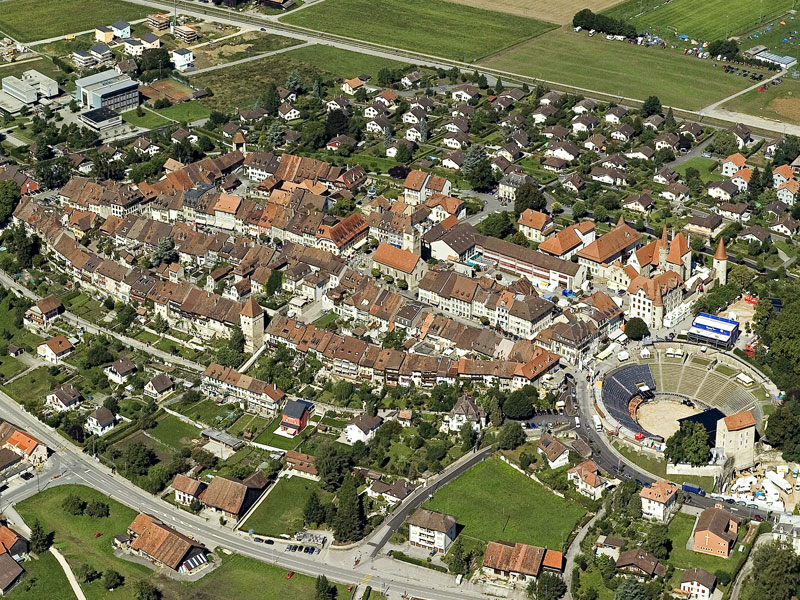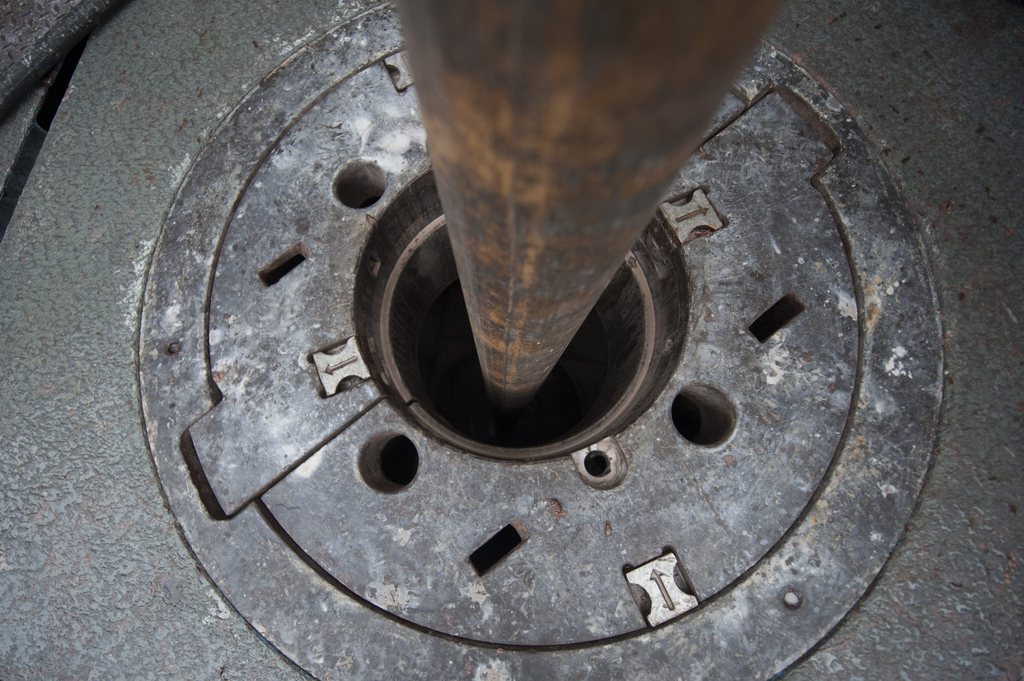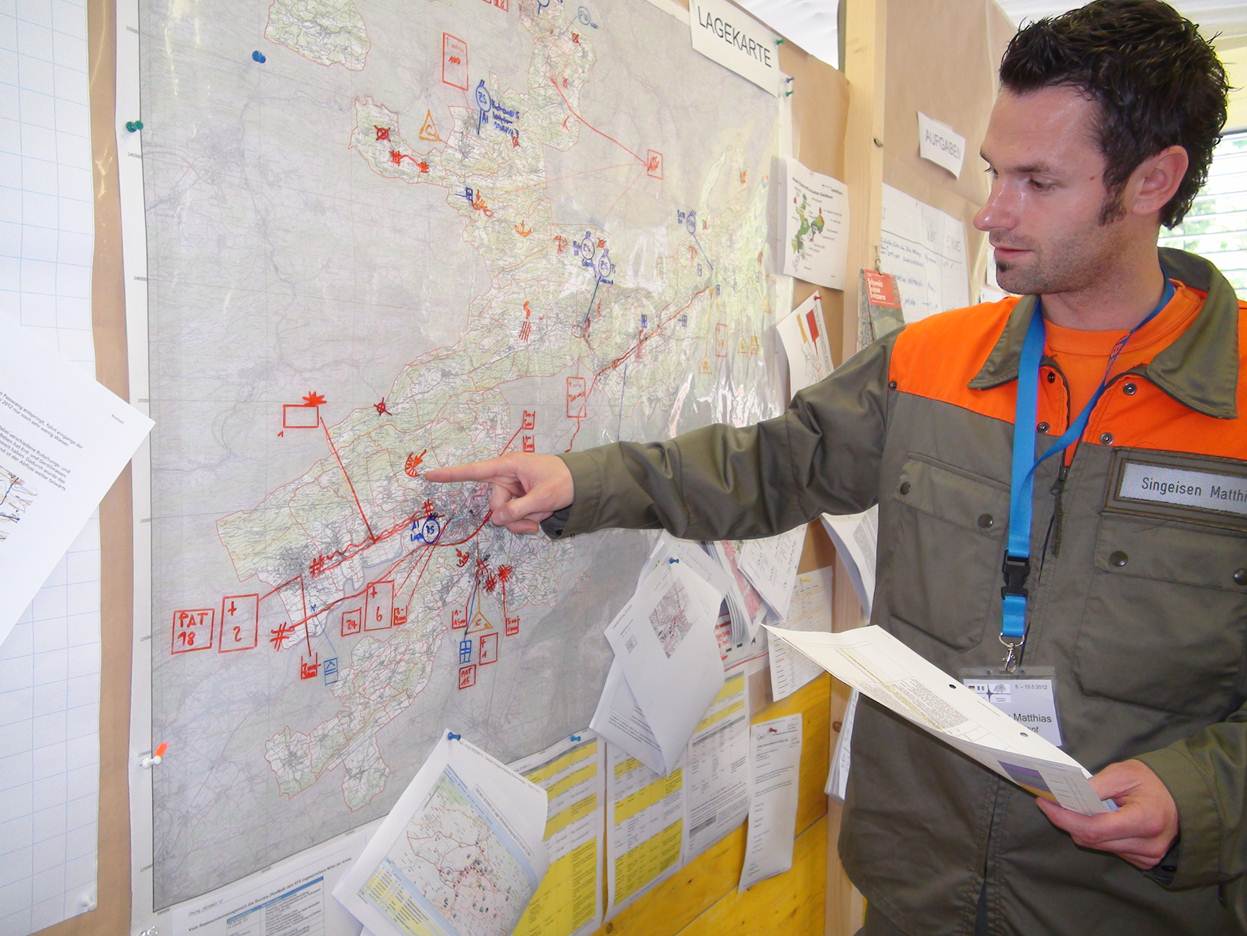Controversial geothermal tech attempts comeback

The Swiss government is ready to place a bet on geothermal energy as part of its 2050 energy strategy, but its promoters have yet to demonstrate its viability and whether they can convince the population of its potential as a safe power source.
Avenches is the former capital of Roman Switzerland. It’s also there in the small city’s industrial zone that a controversial geothermal technology could be making a comeback.
Geo-Energie Suisse has chosen it as one of three potential sites to develop a so-called Enhanced Geothermal System (EGS) that could provide heat and electricity for the town. However, whether it will actually go ahead is a different matter.
The goal is to drill down deep – 4,000 metres or more – into the earth’s crust where temperatures rise as high as 200 degrees Celsius. Water under pressure is injected into the rock -fracturing it – and recovered after it has been heated and transformed into electricity.
A previous EGS project in Basel, the country’s first, was shut down in 2006 after water was injected into the drill well, causing a series of minor earthquakes that caused up to CHF9 million in damage.
The project was terminated in 2009 after a report found that tremors would be a regular occurrence at the Basel site, which also happens to be near a fault line.
The technology involved is not dead though. With the Swiss government wanting geothermal power to cover up to seven per cent of the country’s electricity needs by 2050, energy specialists are ready to give it a second look and are confident it is applicable.
“Basel was stopped because of an earthquake,” said Olivier Zingg of Geo-Energie Suisse. “But using the data from that project, we were able to develop a new concept that helps manage seismic risks.”
Tiny earthquakes are in fact part and parcel of EGS technology. Every time rock is fractured, it releases seismic energy, a core element of the method.
“The trick is to stimulate seismic activity without causing damage at the surface,” added Zingg.
Convincing the population
At first glance, Avenches would not seem like the best option for such a project with an uncertain outcome with its Roman ruins and medieval city, but it does fulfil a series of criteria such as geology, land management regulations and a simpler cantonal authorisation procedure.
In Avenches, the available land and the possibility of providing excess heat to the local district heating system were also among the factors that helped clinch the deal.
For Daniel Troillet, the town’s mayor, encouraging the project makes sense with Switzerland’s moves to phase out nuclear power.
“The nearby Mühleberg nuclear power plant is old and dangerous,” he told swissinfo.ch. “We cannot ignore technology that could help us make up for the shortfall when it shuts down.”
Troillet is convinced the technology has evolved sufficiently to try it out again. Its promoters have also sought the support of the population, presenting the project to the local community earlier this year.
“We realise we won’t be able to convince everybody, but we need to get a majority on our side,” said Zingg. “We need to get across that we are taking people’s concerns seriously and that we are trying to minimize the risks associated with the project.”
The mayor says that so far no one has opposed the project officially, although it is early days in the approval process. Geo-Energie Suisse has also promised special monitoring every step of the way if it gets the go-ahead.
“There is no such thing as zero risk, which is why we have already surveyed a number of buildings, installed detectors, and if damage does occur we will be able to determine if our project caused it,” added Zingg.
So far, there is little audible opposition to geothermal power in Switzerland. Any disagreement focuses on rather which renewable energy will get federal subsidies and support.
Using heat generated by the earth is nothing new in Switzerland or elsewhere for that matter. Thermal baths are an old tradition in some parts of the country, while hot water from tunnels has been used recently for more exotic uses, such as growing tropical fruit or producing caviar.
However, geothermal resources have only been tapped for heat so far, relying on underground hot water sources and only nine facilities of this type are operational. Of three others under construction, only one in St Gallen may produce electricity along with heat.
Geo-Energie Suisse is considering three project sites for EGS: Avenches, Haute-Sorne in canton Jura and Etzwilen in canton Thurgau. Drilling bore holes would not take place before 2016 at the earliest.
According to the Geothermie lobby group, the potential for geothermal power for Switzerland is 80,000 TWh (terawatt hour). Annual Swiss electricity consumption is around 60TWh, while the government’s 2050 energy strategy calls for production of around 4.4TWh from geothermal resources (today it is zero). By way of comparison, electricity users are billed by kWh.
Immature
On paper EGS appears to be the best adapted technology for the country as it could be used almost everywhere. Other projects have sought hot water in the depths, a simpler and different approach to EGS, most recently near St Gallen, but this is a hit-and-miss affair given the lack of knowledge of the Swiss underground.
“We know very little about what can be found,” said Gunter Siddiqi of the Federal Office of Energy. “There are very few drilling installations that have gone as deep as 3,000 metres, and just ten for example over tens of thousands of square kilometres is a really low figure.”
According to Zingg, EGS overcomes this obstacle and once the technology is mature, facilities could be built where energy is needed the most, on the Swiss plateau between Geneva and St Gallen.
Geothermal energy is among a number of renewable sources that could make up a substantial share of the Swiss power mix by 2050 according to government plans. Siddiqi says that EGS could play a significant role.
Unlike sun or wind power though, its true potential is still a big question mark since there isn’t a single functioning facility in operation in the country.
EGS systems are currently being trialled or have been in six other countries – France, Germany, the Netherlands, Japan, the United States and Australia – but tests have been hindered by technical difficulties. Commercial use is limited to just two sites in the Netherlands and Germany so far.
Cost factor
Cost is another factor that could hinder further development according to Siddqi, especially as it remains to be seen if such facilities could be economically viable.
“We have to invest a lot in research so the costs of drilling can be lowered for example, or to improve the transformation of heat into electrical power,” he added.
Promoters of geothermal projects must so far fend for themselves. Despite the backing of the local authorities in Avenches, Geo-Energie, which is owned by a group of seven power companies, is not receiving any public funding.
“The commune and canton do not spend anything,” said Zingg, who points out that the onus is on the shareholders to prove the technology is viable before expecting any financial aid.
Some of the sting might be taken out of the financial risk. If the government’s new energy strategy is approved, drilling costs could be covered up to 60 per cent by the federal authorities if a project does not live up to expectations.
The estimated cost for a production facility is now CHF20,000 ($21,000) per kilowatt, but energy specialists expect it to drop over time as low as CHF8,000. Even so, power companies would have to invest billions to reach the target set by the government.
According to Siddiqi, geothermal projects would however benefit from being able to charge special, higher electricity rates because the technology is still under development, much along the lines of what has been used to promote solar energy.
A naturally occurring geothermal system, known as a hydrothermal system, is defined by three key elements: heat, fluid, and permeability at depth.
An Enhanced Geothermal System (EGS) is a man-made reservoir, created where there is hot rock but insufficient or little natural permeability or fluid saturation. In an EGS, fluid is injected into the subsurface under carefully controlled conditions, which cause pre-existing fractures to re-open, creating permeability.
Increased permeability allows fluid to circulate throughout the now-fractured rock and to transport heat to the surface where electricity can be generated.
Source: US Department of Energy

In compliance with the JTI standards
More: SWI swissinfo.ch certified by the Journalism Trust Initiative



You can find an overview of ongoing debates with our journalists here. Please join us!
If you want to start a conversation about a topic raised in this article or want to report factual errors, email us at english@swissinfo.ch.